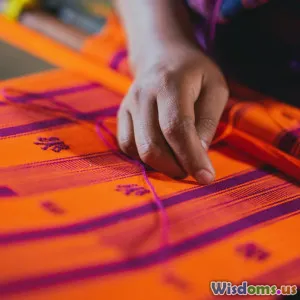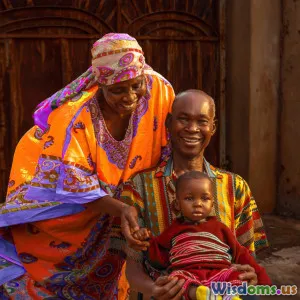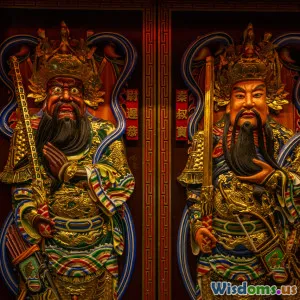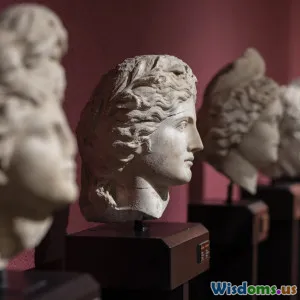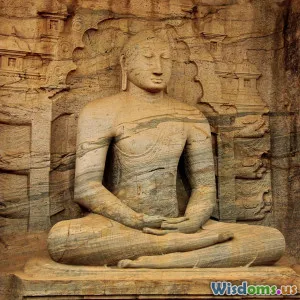
Top 7 Unusual Elements in Lesser Known African Creation Legends
9 min read Explore seven extraordinary elements from lesser-known African creation legends that challenge and enrich traditional mythology. (0 Reviews)
Top 7 Unusual Elements in Lesser Known African Creation Legends
Africa’s vast cultural landscape is home to thousands of invaluable myths and legends, many rooted deeply in creation stories. While mainstream narratives surrounding African mythology often highlight gods, ancestors, or famous epics, there exist lesser-known legends that puzzle, intrigue, and captivate with unusual elements that challenge standard creation story archetypes. These unique facets not only expand our understanding of mythology but give us a deeper appreciation of the philosophies, environment, and spiritualities of different African peoples.
In this article, we will delve into seven remarkable yet relatively obscure elements from African creation legends that stand apart for their curious features and symbolic depths.
1. The Cosmic Egg: Birth of the Universe in the Fang Mythology (Gabon)
One of the most captivating unusual motifs observed in Fang mythology is the “Cosmic Egg” concept. The Fang people’s creation tale describes the universe as hatching from a primordial egg, a metaphor that resonates with certain Eastern and Polynesian motifs but remains rare in African accounts.
According to Fang belief, Obamba Nzila, the supreme god, incubated the cosmic egg, giving rise to the first cosmic elements and life forms once it cracked. This egg represented the primal unity encompassing sky, earth, and sea beneath an initially absolute darkness.
“The universe springs forth from this single vessel, an emblem of connectedness and origin unlike the fragmented chaos seen in other tales,” noted anthropologist Jean K. Biyoko (Journal of African Studies, 2019).
The egg theme contrasts with other African origin accounts where creation often starts with a divine word or ancestor, emphasizing a mysterious hidden womb-like state, hinting at themes of potentiality and destiny.
2. Shape-Shifting Mud Creatures in the Batammariba Tradition (Benin/Togo)
The Batammariba people recount a creation myth where the earliest beings emerged as living mud creatures capable of shape-shifting between animals and humans. These entities molded themselves from the earth's raw clay and water, gradually evolving into humankind.
Unlike mere symbolism of earth origin common in African myths, these creatures engage interactively with their environment, revealing an intimate and literal bond between humans and the soil.
This chimeric animism reflects in Batammariba’s architectural style—houses resembling the human and animal forms interwoven—which anthropologists link directly to their cosmogonical narratives.
Example: A story from Batammariba elders describes a mud creature turning into a falcon to scout the land before taking human shape to build the first society.
3. The Living Landscape: The Mbuti’s Forest as a Cosmic Being (Democratic Republic of Congo)
The Mbuti pygmies see the dense Ituri forest not just as an ecosystem but a living, sentient entity that envelops creation within its body. Their legends depict the forest itself as being born from a divine breath and actively crafting the world and life within its boundaries.
This unusual concept blurs lines between deity and environment, emphasizing ecology in spiritual mythology.
As anthropologist Colin Turnbull wrote: “Among the Mbuti, the forest is an incarnation of creation’s essence. To know the forest is to know life’s beginnings.”
This approach fosters a profound environmental ethic, where harming the forest equates to disrupting cosmic harmony.
4. The Paradoxical Trickster God-Bird of the Aka People (Central African Republic)
The Aka people recount the creation involving a dual-natured trickster god often symbolized by a bird with a human face. This deity is known for creating through contradictory acts—both destroying and forming worlds simultaneously.
The myth reveals how chaos and order are eternally interwoven. The trickster’s paradoxical acts underline humility toward the unknown and the creative powers within the unpredictable.
For instance, one legend tells of the bird’s mimicry of human speech, confusing early humans, which results in both the gift of language and subsequent misunderstandings, thus creating social complexity.
This figure contrasts strongly with all-knowing creator gods more typical in dogmatic stories, offering a richer narrative about existential balance.
5. Water as Primordial Memory: The Nuer’s Fungy Creation Theme (South Sudan)
The Nuer people narrate a creation myth where the first waters contained all the memories of existence, a living archive known as 'fungy.' When the waters receded, these memories organized into forms, shaping both nature and humanity.
Differing from views where water is a chaotic substance, for the Nuer, it preserves the cosmic history. Life emerges not by random chance but through conscious memory encoded in water’s depths.
Memoirs of community elders often invoke this concept to reinforce identity and continuity, linking personal and collective pasts to this sacred source.
6. The Musical Creation: The Dogon’s Cosmic Drumbeat (Mali)
In Dogon lore, creation was initiated by a cosmic drumbeat, a vibration that generated everything in existence—from matter to time and space. The sound emerges from Amma, the supreme god, whose rhythm formed galaxies, spirits, and life.
This linking of music and creation symbolizes cosmic harmony and cycles of existence. The reverberation conveys not only physical but metaphysical origins.
The Dogon celebrate this concept annually through elaborate dances and drum performances, reaffirming the universe's rhythmic heartbeat, indicating how mythology intertwines directly with culture and ritual.
7. Mirror Worlds and Dual Realities in the Chokwe Mythology (Angola)
Within Chokwe beliefs exists the image of two mirror worlds—one tangible, our physical realm, and another invisible, spiritual realm that reflects and interacts with ours.
Creation stories describe ancestors emerging from this invisible world and stepping into reality, making the origin not a single event but a dynamic unfolding between two planes.
This duality accounts for the belief in spirits influencing everyday life and the necessity of maintaining balance between realms for health and prosperity.
The concept differs markedly from more linear creation accounts and enriches African cosmologies with layered perspectives on existence.
Conclusion
These seven unusual elements found in lesser-known African creation legends unlock profound philosophies and cultural insights beyond common narratives. From the cosmic egg to musical vibrations, shape-shifting mud beings to sentient forests, these stories emphasize themes of interconnectedness, balance, memory, and dynamic universes.
Appreciating these uncommon motifs not only broadens our mythological knowledge but fosters respect for Africa’s deep spiritual diversity and its relationship to nature, existence, and cosmos. These lesser-known tales invite us to reconsider creation itself, encouraging curiosity, humility, and wonder at the world’s enduring mysteries.
Reading and preserving these narratives is a crucial step toward embracing a more inclusive global heritage where all cultural wisdom shapes our understanding of origin, identity, and the human journey.
Rate the Post
User Reviews
Other posts in Cosmology
Popular Posts












